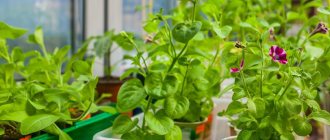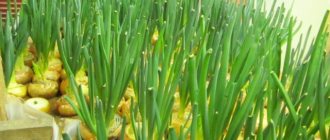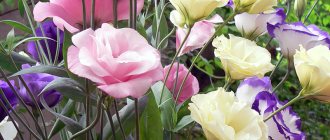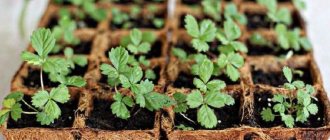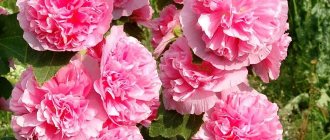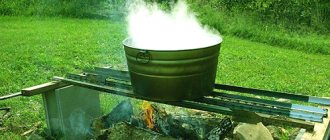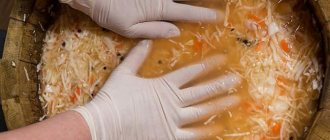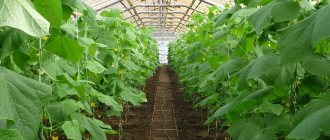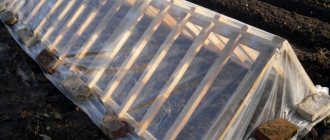The flowers, familiar to everyone since childhood, owe their name to their external resemblance to miniature bells. Even in Latin they are officially called “Campanula” - bell. We also often affectionately call them bells, chenilles, and chebotki. Like many flowers, they are sung in beautiful legends.
According to one of them, the first church bell was created in the image of this tender, fragile gift of nature. It was after their quiet ringing was heard after the wind blew that the priest ordered a copper mold to be cast for the temple in the image and likeness of a flower. Even today there is a belief that their quiet crystal ringing can be heard on Ivan Kupala. Another legend tells about the growth of bells on the site of the scattered fragments of the mirror of the goddess Venus.
Many peoples perceive the bell as a good talisman, capable of driving away all evil spirits with its ringing. It is considered a symbol of faith, joy, openness, increase in wisdom, and harmony between Man and Heaven.
There is a sign that bells dream of good news, good changes in your personal life, and a warning against rash actions. And the enthusiastic praise of this flower by poets and artists deserves a separate discussion.
The desire to get an armful of bells is indomitable, but the picked bells quickly fade... In order to admire them for a long time, it is better to grow them in nature or in your apartment. We invite you to get acquainted with the characteristics of flowers and methods of growing them more specifically.
Description of the flower
The bellflower family of the herbaceous genus has more than 300 species. They grow in the temperate climates of Europe, Asia, the Caucasus, Siberia, and North America. They can be seen in the steppes, meadows, mountains, on rocks, and desert areas.
The shape of flowers up to 7 cm long resembles inverted glasses, bells with edges that curve outward. Their surface can be smooth or terry with a variety of colors (white, blue, purple, pink).
Along with racemose, paniculate inflorescences, there are also solitary flowers. Their ripe fruits look like a box with up to 6 slot-like holes.
Until recently, most bluebells were garden flowers, with the exception of indoor even-leaved flowers. Their varieties Alba and Mayi with white and light blue flowers are called bride and groom.
However, today other low-growing, compact terry plants have appeared, which are grown not only in open ground, but also indoors.
A little about bells: brief information
The genus of bells (Campanula) includes 300 species. These are cosmopolitan plants that are found in different latitudes and climatic zones. They delight with little blue islands in the mountains, forests and meadows. Bells are characterized by:
- herbaceous form;
- alternately arranged, simple leaves;
- different heights: from low to large forms;
- coloring of the corolla in various blue shades;
- inflorescence in the form of a panicle or brush;
- sometimes - a single arrangement of flowers;
- fruit in the form of a capsule filled with small seeds.
Marina Ivanova
He is an expert in his field and an experienced flower growing practitioner.
Ask a Question
Note: The name of the bell is telling: it really looks like a bell. The variety of natural species and created varieties allows each gardener to find his own variety of garden bell, which is traditionally grown from seed.
Types and varieties of bells with photos
They are divided into a significant number of species and subspecies, hybrids. The main criteria for classification as a particular species or variety are the height and timing of growth of these flowers.
Due to the different heights of straight, stiff-haired stems with alternate leaves and bell-shaped flowers, the following types are distinguished:
- short (from 6 to 20 cm)
- medium height (up to 1 m)
- tall (more than 1 m).
Along with these characteristics, the entire number of flowers is divided, first of all, according to the timing of their growth: one- and two-year-old, perennial. To choose the right option among the many varieties of Campanula, let's look at the most popular of them among our gardeners.
- Annual bells came to us from the southern regions. In places with cool and temperate climates they are less common.
Among them there are plants of both low and medium height. Here the most popular plant is the eponymous bellflower, low-growing, forked (dichotomous), Kashmiri. Due to their small growth, the flowers look great near borders and on rock gardens.
The low-growing California bellflower (Phacelia campanulata) with dark shades of flowers never tires of winning its fans. It is cultivated mainly for decorating slides, borders, container groups, etc.
Phacelia California bluebell
Medium-growing summer varieties are also very popular in our area: long-columnar and, as if in memory of an ancient legend, the Mirror of Venus. Despite their short lifespan, their numerous flowers from May to early autumn delight with their different colors.
- Biennial flowers are the most common “natives” from the subalpine zone of the Mediterranean, the Adriatic, Asia Minor and even Siberia. Having grown up in their native climate, they take root well in our country under similar conditions. These include low-growing bearded bluebells.
Among the medium-growing ones, Campanula Medium (medium) can be called a favorite. It has been known since the end of the 16th century and is prone to natural renewal, which is why it is sometimes grown as a perennial option.
Campanula medium Campanula medium
This species has several varieties, where the Cup and Saucer is especially popular among many gardeners.
Bell Cup and saucer
This plant is interesting for its flowers like a cup with gracefully curved edges and a thin porcelain saucer. The beauty is collected in a large inflorescence, which can accommodate about 50 bells with a diameter of up to 8 cm and a wide color palette.
Along with them, varieties of coarse-haired, Hoffman, thyrsus-shaped, and spicate bells are also popular. In many gardens, such biennials are grown as: Siberian, Moesian, laurel, spatulate, divergent, spreading, pyramidal, Sartori, Formateca, etc.
- Perennial species are found much more often than those growing for 1-2 years. They are also divided into subgroups depending on the height of the plant.
Among the low-growing species, the leader in prevalence is the Carpathian bellflower, born in the mountains of Central Europe. It has been known in floriculture for about 250 years. The plant barely reaches 30 cm and has stems with densely arranged leaves. However, it is short-lived, because it lives in one place for no more than three years.
Bluebell Carpathian
Its most famous garden forms are Alba and White Star with snow-white single funnel-shaped flowers. These are also Isabel, Celestina, Blaumeize, Riverslea, Centon Joy, Karpatenkrone with sky blue, blue, purple flowers with a diameter of up to 5 cm. And if these varieties are more adapted to open spaces, then the miniature Klip can also be grown as an indoor crop.
Popular low-growing bells also include varieties Gargan, spiral-leaved (spoon-leaved), birch-leaved, daisy-leaved, Ortana, Radde, three-toothed, Shamisso, Uemura and many others.
Medium-sized perennials are represented by Takeshima and Komarov bells, dotted with numerous stems, simple and double flowers of various colors and sizes. Here the best varieties are considered to be Beautyful Trust, Wedding Bells, Alba-nana, Rubra.
BELL TAKESHIMA "Beautiful Trust"
It is worth paying attention to the hardy Platycodon, which is often called broadleaf. It is notable for its luxurious double large flowers of various colors. Its best varieties are Album, Nanum, Marisil, Pleno Alba and a number of others.
Platycodon grandiflora Fuji Pink
Among this subgroup, the most popular medium bell with double flowers should again be mentioned. It is very unpretentious, cold-resistant, but loves bright places with moist soil. Its lifespan can be long due to self-seeding (natural renewal). In warm regions, Campanula Medium opens its buds even in the first year of planting seeds.
Tall perennials grow in their natural environment along river banks and in the forests of Europe, Russia, Ukraine, Siberia, and Asia Minor. Varieties have been bred in the culture, the names of which indicate the characteristics of the leaves.
They differ not only in the height of the stem, but in the richer aroma of the flowers. Some names focus attention on the color of the flower, for example, milky (Cerulea, Pritchard Verajeti).
This category also includes noble-flowered, Bolognese, nettle-leaved with double flowers, crowded, rapunzel-shaped bells. Along with them, peach leaves are very popular (Bernice, Tetham Beauty, Exmouth, Snowdrift, New Giant Hybrids).
Bellflower peach
This far from complete review allows you to get an idea of the wide selection of bells for growing on your property, balcony, or room.
The best conditions for the growth of bellflower
First of all, you need to choose a sunny area for planting, since the bell feels better in an open, well-lit place. The soil should be well-drained with a neutral or slightly alkaline pH. This flower does not like acidic and slightly acidic soils. Therefore, it is periodically recommended to alkalize the soil by mixing it with wood ash. Moderate watering is necessary - this flower does not tolerate stagnation of water. Subject to these conditions, the maximum number of buds is ensured.
The ideal climate is warm and cool, but the flower does not tolerate heat and frost well. During the cold winter months, seeds in the soil can withstand up to -30°C...-35°C.
Depending on the variety, the height of the stems ranges from 50 to 100 cm and above, and the number of buds ranges from 45 to 50 pieces. The bud size can reach 7 cm, and the most active flowering time is usually June-August.
Growing from seeds
This method is the most universal, and the only one for annual bells. It can also be successfully used for biennials and perennials, except for varieties with double flowers. The exclusion of the latter is explained by the fact that the seedlings are not able to retain these characteristics or the seeds may not set.
Preparation of seeds and soil does not involve the use of complex agricultural techniques. Bell seeds do not require preliminary preparation for sowing. Regarding the soil, some plant varieties are well adapted to calcareous, rocky places. However, most varieties of bluebells are suitable for neutral/slightly alkaline soil, well-drained loam.
Preparing the soil chosen for planting flowers involves deep digging. For heavy soil, sand or humus is added, and depleted areas are enriched with humus and fertilizers. At the same time, in order to avoid the risk of fungal diseases, you should not use fresh peat or manure that has not completely rotted.
Sowing and caring for seedlings
Using the seed method for growing seedlings allows you to see flowers already in the first year after planting.
- To do this, small seeds are sown in containers with soil prepared in advance from March.
- At the same time, they are lightly pressed with the palm of your hand, and not sprinkled with earth.
- The substrate must be light, loose, permeable and pre-moistened.
- This is achieved by mixing turf soil, humus coarse sand in a ratio of 6x3x1.
After sowing, the contents of the container are sprayed with water, covered with film and placed in a warm place up to +20 ºC. After 15-20 days, shoots appear, seedlings are transferred to a place where direct rays of the sun do not reach.
Here, traditional care for seedlings of many flowers is carried out without covering with film. This is watering when the top layer of the substrate dries, careful loosening around the young shoots.
When the first true leaves appear, after 20-24 days, diving is carried out into separate containers at a distance of at least 10 cm. After this, after 2 weeks, the shoots should be fed with a liquid, weakly concentrated complex fertilizer.
Sowing work
The process of sowing seeds is not complicated; you should follow the instructions:
- A drainage layer 1 cm thick is placed at the bottom of the container. Perlite or expanded clay can be used as drainage.
- Fill the container with soil. You should not fill it to the brim; it is better to leave 1-2 cm free to the top.
- The soil is moistened with warm, settled water.
- Then surface landing is carried out. The seeds are sown on the ground and lightly pressed down.
- Spray the soil using a spray bottle.
- Cover the top with a transparent lid or cling film. This creates a greenhouse effect.
The optimal air temperature in the room with containers is +20-22°C.
The seeds should be kept under the film until the first shoots. In order for the plant to receive enough oxygen and light, it is necessary to remove the covering material for 30 minutes once a day.
Planting in open ground
Sowing seeds directly into open ground is done before winter in the 2nd half of October or in spring (end of May). When sowing in autumn, the natural selection of full-fledged seeds will take place in the winter, and the strongest of them will sprout together in the spring. These seedlings can be used for planting in the chosen location.
May sowing requires stratification lasting 2 months. However, this somewhat lengthens the path from seed germination to flowering plants.
It should be taken into account that bells sown in this way are used for the first year to develop roots and leaf rosettes. Only in the second year of life do they grow shoots with flower ovaries.
Grown seedlings are planted in open ground from the end of May to the end of the first ten days of June. When choosing a location on a site, you should give preference to light or slightly shaded areas without drafts. It is advisable to place the bells away from trees and bushes to obtain sufficient nutrition and moisture.
When planting low-growing seedlings, the distance between flowers should be up to 15 cm, medium-growing - up to 30 cm, tall - up to 50 cm. Upon completion of planting, the soil near future bells is carefully compacted and well moistened.
To preserve moisture and prevent the appearance of weeds, the row spaces can be mulched. Gardeners note that thanks to seedlings, you can admire flowers already in the first year of their earthly life.
When to plant the middle bell for seedlings
Moderate watering is necessary - this flower does not tolerate stagnant water.
In order for this magical biennial to bloom on time, it is necessary to sow its seeds for seedlings in a timely manner. This directly determines how long you will admire the blooms.
General terms
As a rule, seeds for seedlings are planted in mid-late April, and planting on the site occurs in the last ten days of May, when night frosts have completely subsided. But if you really want to get flowering in the first year, then you need to plant the seeds in March.
Depending on the region, bells should be planted at the following times:
- For the southern regions, it will be optimal to plant seeds in early March.
- In the Moscow region and the central zone - in the third ten days of March.
- In the Urals, Siberia and Leningrad region - in early April.
Lucky and unlucky days according to the lunar calendar
It is necessary to sow seeds for seedlings in a timely manner.
All bells are represented mainly by perennial plants. However, there are also annual varieties. For those summer residents who prefer to be guided by the advice of astrologers, we recommend that you familiarize yourself with the favorable and unfavorable days for planting plants from the 2022 lunar calendar and take them into account when working on the site:
| Month | Favorable days for sowing annuals | Favorable days for sowing perennials | Unfavorable days for sowing seeds |
| January | 27, 27, 29 | – | 10, 25, 26 |
| February | 1-8, 10-20, 25-29 | 1-8, 10-20, 25-29 | 9, 21-23 |
| March | 2-8, 10-14, 29-31 | 4-6, 12-14, 26-28, 29-31 | 9, 19-21, 24 |
| April | 1, 2, 5-7, 9, 18-20, 24, 25 | 1, 2, 5-7, 9, 13, 14, 24, 25 | 8, 15-17, 23 |
It should also be remembered that on the days of the new and full moon it is extremely undesirable to carry out any work with plants.
Caring for flowers in summer
Bell Raspberry ringing
One of the attractive qualities of bluebells is their ease of care. It consists of regular watering during hot weather, further loosening the soil around the flowers, and removing weeds. Tall varieties will need staking or securing to supports.
- Fertilizing is carried out in the spring with nitrogen fertilizer to increase the vegetative mass and earlier flowering.
- During budding in early summer, phosphorus or complex additives are needed.
- In autumn, potassium fertilizers are applied to increase the winter hardiness of the plant.
- If a particular variety prefers the soil to an alkaline, neutral reaction, it is important to reduce the existing acidity with the help of ash.
- In summer, moderate application of rotted humus is appropriate.
In order to extend the flowering time, it is necessary to remove fading inflorescences. At the same time, all faded shoots of tall varieties are cut off. If you plan to collect seeds, then browned, but not yet opened, boxes are left on the plant.
Perennial bells after flowering
How and when to collect seeds
If you want to get seeds of your favorite species, then do not wait for the boxes to open; cut off the inflorescences left for the seeds in advance, as soon as the boxes acquire a brown tint, and ripen them in a ventilated, dry room.
Preparing for winter
Planting and caring for perennial bluebells is no different from growing annual or biennial varieties, except that they need to be prepared for winter. At the end of September or beginning of October, the stems of all bells are cut off at the root. This completes the care of annual flowers. As for biennial and perennial species, many of them overwinter without shelter, but southern species need to be covered with dry leaves or covered with spruce branches. Tall bells are covered with a layer of humus or dry peat 15-20 cm high. This will be enough for perennial bells to survive the winter.
How to collect seeds
For long-term cultivation of your favorite bells, seeds are collected from mid-August to the end of September. It is noteworthy that 1 g contains up to 5,000 small, light seeds.
Harvesting begins after the boxes turn brown and are about to open. Pre-cut inflorescences should be placed on thick paper or canvas in a dry, well-ventilated room.
Clean the crumbled seeds from the remains of bolls and dried leaves, and then use them for growing seedlings or in open ground.
In case of delay in timely collection, they are allowed to fall on the ground. Due to self-seeding, the cycle of seed convergence will be repeated without additional stratification and all the processes of growing bells.
How to care for seedlings
Caring for seedlings is an extremely important stage. If certain rules are not followed, the seedlings may die.
Temperature, lighting and watering
After the seedlings emerge, the containers are placed on a sunny windowsill; the air temperature in the room should be +18-22°C. Recommended daylight hours are 12-14 hours. If there is not enough natural light, it is necessary to supplement the seedlings with phytolamps.
Water the seedlings from a syringe or syringe, pouring water in a thin stream under the root. In this case, you need to make sure that it does not get on the leaves. The soil should always be slightly moist.
How and when to pick seedlings
The plant is picked after the appearance of 2-3 true leaves. For this, use individual containers; a volume of 200 ml will be sufficient. Before transplanting, it is necessary to make drainage holes in them. You can use the same soil that was used for sowing the seeds.
Before picking, water the seedlings and leave for 1 hour. The soil will become softer and the seedlings will be easier to remove.
A drainage layer 1-2 cm thick is placed in new containers, filled with soil and small depressions are made. Carefully move the plant along with the lump of earth. It is better to remove seedlings using a spoon or fork. The bell has long roots that are easily damaged.
After transplanting the seedlings into a new container, the soil is compacted. Water with settled water at room temperature. To protect the plant from unnecessary stress, the seedlings are kept in shaded areas for the first 2-3 days after diving.
Top dressing
The first feeding is carried out 2 weeks after picking. Use complex mineral fertilizer for flowering plants, for example, Agricola. Repeated application of fertilizers is repeated after 10-14 days.
Hardening of seedlings
2 weeks before planting seedlings in open ground, a hardening procedure should be carried out. To do this, open a window in the room for 30 minutes. Every day the time is increased by 1 hour. 1 week before planting, the containers are taken outside for 2 hours, also increasing the time spent on the street every day.
Diseases and pests
Among the many advantages of bells is their resistance to pests and diseases. These undesirable phenomena can occur when flowers are grown in one place for a long time. Indeed, in this case, the soil accumulates various harmful microorganisms.
And their constant presence in contact with plants provokes disastrous consequences for them. Treatment of flowers with a weak solution of Fundazol helps to avoid such negative phenomena.
Excessive humidity can favor the appearance of slugs. Here, an effective means of control can be spraying the plants with a decoction of hot pepper or superphosphate granules sprinkled between the flowers.
Application in the garden
“Cup and saucer” is good in borders, flower beds, mass plantings, and mixborders. It will look great near the lawn or in small groups.
What is the middle bell combined with?
It looks great with many cultures:
- Garden geranium.
- Carnation.
- Cuff.
- Looks amazing in combination with roses, especially pink shades. The photo below does not convey the beauty of the combination of delicate bell-shaped “cups” and lush buds.
Pairs well with grains and herbs. Can be grown in container culture: pots, tubs, vases.
Medium bell, carnation, horned viola.
Use medium bell for cutting - flowers in water remain fresh for up to 2 weeks.
Photo of a bell in the landscape, in a flowerbed, in compositions:
Reproduction
Along with the seed seedling method, there are other options, the use of which depends on the biological characteristics of the variety and plant type. So, if one-year-old bells reproduce by seeds, then two-year-old bells prefer vegetative ones (by seeds and cuttings).
Species of perennials with taproot and carpal root systems are considered vegetatively immobile and can reproduce by their seeds. Plants with creeping long roots, classified as vegetatively mobile species, tolerate all these methods + bush division well.
However, it is better to propagate perennial flowers:
- parts of rhizomes,
- root cuttings,
- stolons,
- dividing the bush.
Despite the possibility of seed reproduction, these species lose their generic characteristics. This is especially reflected in double varieties, which even lose their ability to produce seeds.
With the vegetative method, cuttings are prepared in the spring. From early March to mid-April, they are cut from young basal or stem shoots. Then they are planted in a loose substrate and placed in microgreenhouses, under a film to maintain optimal humidity. Within a month, the cuttings begin to grow roots, after the development of which, you can begin planting the plant.
The use of propagation by dividing the bush is permissible after 2-3 years of plant life. To do this, in May-June, a large bush is selected, dug up, and the above-ground stems are cut off.
Dividing the bush into parts is carried out with a sterile, sharp garden knife. Each part must contain developed healthy roots and renewal buds. The cutting areas of each cutting are treated with crushed coal or ash, and then immediately planted in abundantly watered soil.
When propagating rhizomes in parts, only the creeping part is dug up, from which cuttings from the mother plant with renewal buds are made. They are planted in the ground with an open bud above the soil surface.
Varieties
Cup and saucer is the name not so much of a variety as of a variety group. Under this name, many agricultural companies, including foreign ones, produce seeds, most often mixtures of various colors (in English “Cup & Sauser”). All cups and saucers and Chinese sets (as the Gavrish agricultural company chose to call the plant for its “Lucky Seeds” brand) have double flowers with two skirts, as if nested one inside the other. It really does look like an upside down cup and saucer. The shape of the flowers is very harmonious and beautiful.
Other varieties or mixtures of medium bluebell that can now be found on sale: Raspberry Ring - double, mixture of colors (Russian Ogorod), Cottage - simple, mixture of colors (Johnsons, England), Dream - simple, pink (Sedek), Carminrose - simple juicy carmine pink (Gavrish), Gramophone – simple carmine pink (Plasma). Apart from the colors and degree of flower terry, they have no fundamental differences, so all the recommendations in this article can be safely applied to any seeds whose packaging says medium bell.
7sotok.by
The content of the article:
1. Varieties of bells.
2. Reproduction and planting of bells.
- Placement and soil.
- Propagation by seeds.
- Vegetative propagation.
- Reproduction by dividing the bush.
- Propagation by division of rhizomes.
- Reproduction by root suckers.
3.Caring for bells.
4.Diseases of bells.
Common garden herbaceous plants bloom very beautifully. A characteristic feature of many varieties is the length of the flowering period. The color of bells is very diverse. Flowers can be all shades of blue and purple, pure white or lilac. There are pink and scarlet, sometimes yellow varieties. The height of the bells is equally varied. There are miniature varieties, medium-sized and tall, reaching a height of 1.5 meters. Such varietal diversity predetermines the different uses of plants. Tall ones look great when placed alone. They can also serve as a background for other flowering plants, being placed in the background of the flower garden.
Medium-sized ones are suitable for flower beds and flower beds, especially when combining different color options. Low bells will attractively frame the green lawn. They also look good in flower boxes on the veranda or balcony. Plants of different heights can create a picturesque flower bed (edge) from tiers of different heights.
Varieties of Bluebells.
Pozharsky's bell.
It is distinguished by the star-shaped flowers of blue, blue and violet shades. Creeping plants can decorate a lawn or the shore of a pond. Prone to profuse growth. Tolerates severe frosts.
Portenschlag's bell.
This variety is decorated with clusters of lilac-blue flowers; numerous foliage forms a continuous carpet. Like the previous variety, they can be used for planting in the gaps of paving slabs, and will also take root in the gaps between walls and the foundation. Also prone to overgrowth.
Bluebell Garlic leaf.
It has a vertical inflorescence of bent flowers of pure white color, sometimes with a cream tint. Leaves are heart-shaped, pubescent. Blooms throughout the summer season.
Bluebell Bearded.
With drooping purple or white flowers, unilateral inflorescences. The plant is short-lived.
Bluebell Carpathian.
It comes with white, purple-violet or bright blue flowers. Forms tussocks of leaves.
Bell of Gargansky.
The flowers are star-shaped, pale purple, in spike-shaped inflorescences. Requires increased lighting.
Bluebell Crowded.
It has clusters of flowers at the ends of the stems. A powerful root system and abundant growth sometimes turns this plant into an annoying weed. Its flowers are purple or violet.
Bluebell of Highlandgen.
Good even for rocky soil. The flowers are glass-shaped, double, violet-blue.
Bell Curved.
Characterized by large flowers of light blue-violet color. After the seeds ripen, the plant dies.
Campanula Miltiflora.
It has a large number of small flowers in paniculate inflorescences. The flowers are white or blue, there are blue and pink. Quite a spreading plant.
Bell Prichard Variety Show.
Grows up to 1.5 m, needs support. Has blue-violet flowers.
Campanula broadifolia.
It is distinguished by shiny dark leaves. The pyramid-shaped inflorescences consist of 5-centimeter blue or purple flowers.
Bluebell broad-bladed.
Blooms in mid-summer. Cup-shaped flowers of bright blue color.
Bell Medium.
It has large elongated flowers and blooms in late spring. The colors are very varied - white and pink, purple and blue.
Campanula Peachflower.
The flowers of this plant are blue or blue-violet. Cup-shaped, quite large.
Dark bell.
With single flowers of elegant shape, very bright blue color with almost round leaves. Perennial with creeping stems.
Alba bell.
Pointed bell shape. The creamy white flowers have purple dots on the inside of the petals. The form of Rubriflora flowers is dark pink with red specks.
Bell Pyramid.
The flowers are star-shaped, white or blue, sometimes with a combination of these two colors. Pyramid-shaped inflorescences are pleasing from mid-summer to late autumn.
Rainer's bell.
Perennial of alpine origin. Demanding about the lack of groundwater. Single flowers in the shape of a wide bell are colored blue or violet-blue.
Bellflower Rapunzel.
Inflorescences in the form of a spike of drooping flowers, their color is violet-blue. It grows profusely and can crowd out other plants.
Campanula Roundifolia.
It has a few blue flowers that appear closer to autumn. It can also become a nuisance to plants of other species.
Takeshima bell.
It has large, up to 6 cm long flowers. The white color is shaded by the color of lilac, with red specks inside.
Campanula Thyrsoid.
This variety has yellow flowers that are unusual for bells. Inflorescences in the form of a thick dense spike.
Campanula nettlefolia.
It has elongated inflorescences of 5-centimeter flowers. The flowers are purple or blue-violet.
Zoysia's bell.
A small plant with wavy flowers, their color is lilac-blue. Disadvantage: sensitivity to extreme cold.
Bell Border.
A bell with large, up to 4 cm, glass-shaped flowers. The flowers change color: the buds are burgundy, then fade to pink. Only the veins of the same color remain on the outside.
Prialpine bellflower.
Has blue single flowers. The alpine origin affects it - it loves rocky soil.
Campanula Cushion-shaped.
A compact, pillow-shaped plant up to 5 cm tall. Small single flowers are blue-violet, leaves are ash-colored. In winter it needs shelter.
Bellflower hairy-flowered.
It has a hairy calyx, the blue wide corolla is cut into ovoid lobes by a third.
Sarmatian bell.
Quite rare, tolerates cold well. Bears a large number of blue flowers with the scent of honey.
Sarasto's bell.
A hybrid with large (up to 7 cm) purple flowers of a classic bell shape. It grows well and is compact. It grows both in sunlit places and in some shade.
Turchaninov's bell.
It can have either single flowers or racemes of up to 5 flowers. The dark blue petals have several longitudinal grooves.
Bluebell Saxifraga.
Low plant, up to 10 cm. The flowers are large, deflected, violet-blue.
Campanula Ciliata.
The flowers are blue-violet, lighter at the calyx and darker towards the tips.
Bell of Pontius.
Interesting because of the unique coloring of the flowers. They have transitions from lilac to purple. There are specimens that are whitish in color.
Grossec bell.
Entirely covered with bristles, the flowers are violet-blue. Can grow in the shade.
Komarov's bell.
Covered in coarse hairs, they make the leaves rough. Blue-violet flowers are very numerous on the bushes.
Bell perforated.
A low plant with large blue flowers in the shape of a strongly dissected star. Blooms long and profusely.
Bell of Bologna.
It has long spike-type inflorescences with many small blue flowers. Can tolerate shade.
Campanula Alsinoides .
Does not exceed 10 cm in height, small white flowers bloom in autumn. Easily propagated by seeds, self-sowing is abundant.
Bell of Otran.
20 cm tall with thin stems. The bluebells are purple and appear in large numbers in early summer.
Bell Povoinichkovy.
Small in height, with rather large flowers, tubular in shape, blue.
Three-toothed bell.
In the wild it grows among the mountains. On the stems there is one flower of a dark purple color.
Radde's bell.
It has flowers at the base of the upper leaves. Their color is light purple. Prefers alkaline soil.
Bluebell Cold-loving.
With stems up to 15 cm, bearing one wide flower bell. The rich blue color attracts attention.
Bell of Ardovsky.
Mountain origin, glabrous stems with single flowers. Narrow bells are painted dark blue, deeply cut into 5 petals.
Oshe's bell.
Caucasian origin. The flowers are purple and have a classic shape.
Bluebell Soddy.
Cushion-shaped, creeping stems intertwined into turf. Single flowers are painted white or blue.
Campanula Noble-Large-flowered.
Large-flowered is also shade-tolerant. More than a meter plant. Flowers 8 cm in diameter, clusters of rich blue color.
Uemura's bell.
A compact plant with a weak root system that requires careful handling. Strongly dissected dark blue flowers in a short raceme. Needs regular watering.
Chamisso bell.
Low-growing, has up to five peduncles. The flowers for a low plant are very large, violet-blue. Blooms until September.
Alpine bells of many varieties are of interest to gardeners. These are Tatra, Moravian, polymorphic, Schweitzer, wonderful, Spanish, carnica, Marchesetti and others.
Reproduction and Planting of Bluebells.
The variety of species and varieties of bells, the difference in the duration of their life cycles, predetermined the variety of methods of reproduction. These plants reproduce in almost every possible way. Of course, not all species are characterized by this. It all depends on the biological characteristics of the plants.
Annuals reproduce exclusively by seed. Biennial species - by cuttings and seeds.
Placement and soil:
The low demands of bluebells on soil quality are somewhat exaggerated. A predominantly neutral or slightly alkaline reaction is needed. Liming is carried out if necessary. Only certain species (for example, bearded bell) require some acidification of the soil.
Bluebells do not tolerate the root system getting wet; in such cases, the roots will not survive the winter. We need soil drainage and removal of excess water, even melt and rain. Plants need to be provided with normal lighting; only some tolerate shade; a few species grow in the shade.
Propagation by seeds:
The capsules - the fruits of the bells - must be harvested before they open. The moment of collection will show the browning of the boxes. They are dried, after which the seeds spill out freely. The seeds are very small in size; For ease of sowing, they are mixed with clean sand. The seeds are used to grow seedlings or sown directly in open ground.
For bell seeds, sowing is used on the soil surface or with minimal depth. You can cover them with a small amount of sand. Spring sowing is carried out in May, germination occurs after 10 days. In the greenhouse, seeds are sown in March in seedling boxes. After 12 days, the bells sprout, they are picked and with the beginning of summer they are planted in the place intended for them.
Autumn or pre-winter sowing is done in October. In this case, seedlings appear when the soil warms up sufficiently. They are thinned out and pruned when the third leaf appears. A possible option is pre-winter sowing in low boxes; they are dug in and covered for the winter. The covering material is removed in the spring, but the boxes are shaded. At the beginning of summer, they are planted on seedling beds, and next spring they are placed in a permanent place.
Vegetative propagation:
All types of vegetative propagation retain the characteristics and properties of the original plants. Such propagation is the only one possible for seedless terry varieties. This is the only way to propagate southern varieties, whose seeds do not have time to ripen in the middle zone.
Cuttings are carried out by cutting off young stem or root shoots of bells. It is better to root freshly cut cuttings; as a last resort, they can be stored for some time at a temperature of about +5 degrees - in the refrigerator or on the balcony. As a rule, the cuttings are first kept in water until the first roots appear. Then rooting continues in sand or light soil. Cuttings need high air humidity. To ensure this, miniature greenhouses are made from inverted glass jars or cut plastic bottles. In this case, to allow air to enter, you need to place something under the edge of the container. Do not over-moisten the soil to prevent the roots from rotting. Half a month is usually enough for rooting, and the seedlings can be transplanted into boxes or pots.
The division of bell bushes depending on the variety is carried out from the 2nd to the 5th year of development. Select large overgrown bushes and carefully remove them from the ground. The above-ground part of the plant is separated and the underground part is divided. Each separated part must have roots and growing points. The separated parts are immediately planted in a permanent place and watered well.
The division of the rhizome is carried out by digging it out from the ground. Each cut section should contain buds. The segments are placed in the ground; the buds should be at ground level. The cut areas are sprinkled with crushed activated carbon for faster healing.
Root suckers are separated from the original plant along with part of the root. They can be immediately placed in their intended place.
Caring for bells.
Fertilizing is carried out in early spring with nitrogen fertilizer. Before the formation of buds, mineral fertilizer is applied. The ash from wood stoves is perfect for bells. The soil must be loosened and weeds removed before flowering. Watering in normal seasons is almost not needed; Water the dry bells sparingly. Of the water-loving varieties, only some varieties of bells (spotted, broad-leaved, Takeshima); they need good watering.
Diseases.
Diseases and flower pests rarely bother bell lovers. This happens if the plants are grown in one place for a long time, so you need to periodically transplant the bells to a new territory. In wet weather, flowers can attract slugs, which can be repelled with a small amount of superphosphate. Bells can be transplanted in autumn or spring. Plants with strong roots are transplanted after the snow cover melts. The rest - after the soil warms up. Autumn replanting should be completed by early September to allow time for rooting. The small root system allows such plants to be replanted at any time, even flowering ones. When replanting, the roots of the plants should be protected from damage by a clod of earth.
Choosing a place to plant a bell
Abundant and long-lasting flowering depends on choosing the right place for planting the bell, and all types require almost the same growing conditions.
The plant grows well on fertile, humus and moist substrates with good permeability, as well as on sandy loam soils rich in calcium. Carpathian bellflower and portenschlag prefer rocky and poor soil.
For other species, poor garden substrates are enriched with compost or humus, adding them in a 3-4 cm layer at the planting site and then digging up the ground. Fresh, unrotted manure is not suitable as a fertilizer because it can cause the development of diseases.
Wood ash as a fertilizer for plants - composition, application and benefits
Before planting Takeshima bell, add a little high-moor peat or dry pine needles to the soil to increase its acidity.
The place for growing garden bells should be sunny and warm, partial shade is also allowed, especially in regions with hot summers.
The best areas of the garden will be places illuminated by the morning or evening sun, since the color of bright flowers can fade under direct rays. It is better to avoid dense plantings, as they impair air circulation, increasing the risk of developing fungal diseases.
